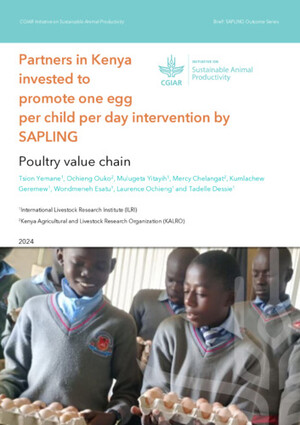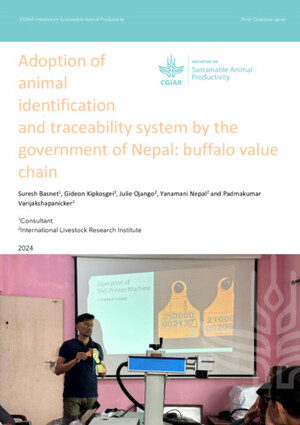
Complementarity of value chain analysis, consumption patterns and nutrition in the design of sustainable, effective and efficient food-system-based interventions
Abstract
Introduction: Adequate and balanced nutrition is key for poverty reduction, maternal and child
health and the achievement of the Sustainable Development Goals. Malnutrition, particularly
micronutrient deficiencies, can be alleviated with nutrient-dense animal-source foods (1). In Nairobi,
Kenya, poor informal settlements represent a challenge to the food supply. The purpose of the
reported study is to understand the dynamics of: 1) food systems supplying animal source foods using
value chain analysis; and 2) consumption patterns of animal-source foods in deprived households.
These two components were then linked to facilitate realistic and proportionate interventions and
inform food policies.
Methods: We conducted two parallel investigations in Nairobi: a cross-sectional nutrition survey in
consumers of 205 randomly selected low-income households, in Korogocho and deprived areas of
West Dagoretti; and a large-scale characterisation and analysis of the different animal-source food
systems of the city. Retailers were the linkage node between consumers and food systems data. In the
household survey, dietary (24-hour recall), anthropometric (weight, height and length), and
biochemical (haemoglobin) data were collected from non-pregnant women of reproductive age and
children (1-3 years). The questionnaire also included quantitative data on animal-source food
consumption patterns and choice drivers, and purchase prices that were used to calculate demand
elasticities. In the food systems study quantitative and qualitative data were collected using value
chain analysis that included constraints, barriers and potential, and the assessment of the involved
food safety and nutritional risks. This analysis included: key informant interviews (e.g. government
officers), focus groups, interviews of all the stakeholder types along the chains (farmers,
abattoir/market owners and workers, transporters, and retailers) and researchers’ observations. Linear
programming (in Optifood) was used to formulate population-specific food-based recommendations,
and model the effect of incorporating different animal-source foods in the diet.
Findings and interpretations: Results in children showed 42% were stunted and 74% were anaemic;
in women, 7.4% had a low and 29% a high- body-mass index and 26% were anaemic. The linear
programming analysis identified specific food-based interventions that would ensure, for example,
dietary adequacy for all nutrients except for iron in women, requiring among others increases of
intake of milk and other animal sources.
The consumption and food systems datasets on animal-source foods were combined to assess
availability, affordability, accessibility, preference, and upscaling potential. For example, beef was
consumed by most households (81%) at an average of 1.5 times per week. Its demand was principally
based on ‘taste’ and ‘nutrition’ indicating that consumption would be responsive to nutrition
education. The reasons why households did not consume beef were either “price” (71%) and/or
‘unknown’ (74%). Own-price elasticity of beef was relatively inelastic at -0.68. Food system analysis
showed that most beef was destined for higher-income areas Slums were limited to stale, low quality
carcases with infrastructure issues producing problems of poor hygiene, food safety and traceability.
The combination of approaches and methods provides a holistic picture of the food systems and its
limitations, which allows more informed decision on interventions for poor people.
Citation
Dominguez-Salas, P., Häsler, B., Ferguson, E., Cornelsen, L., Alonso, S., Fèvre, E.M., Rushton, J., Grace, D. and Alarcon, P. 2015. Complementarity of value chain analysis, consumption patterns and nutrition in the design of sustainable, effective and efficient food-system-based interventions. Presentation at the 5th Leverhulme Centre for Integrative Research on Agriculture and Health (LCIRAH) Annual Research Conference, London, UK, 3-4 June 2015. Nairobi, Kenya: ILRI.









